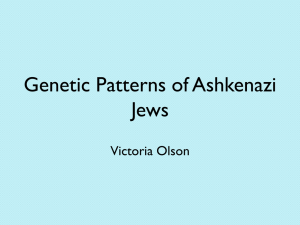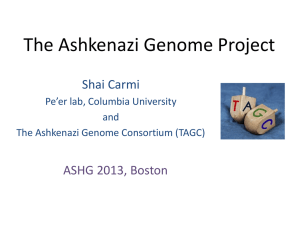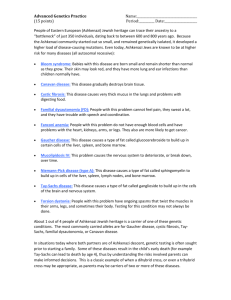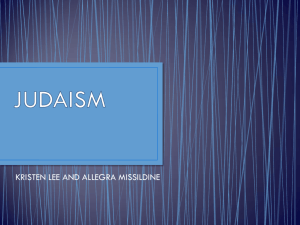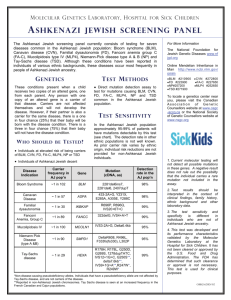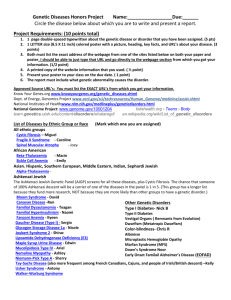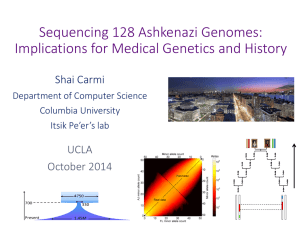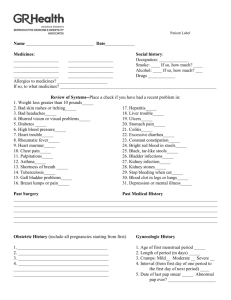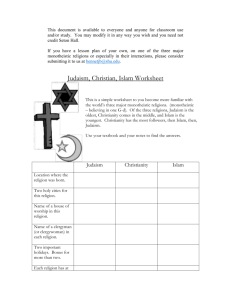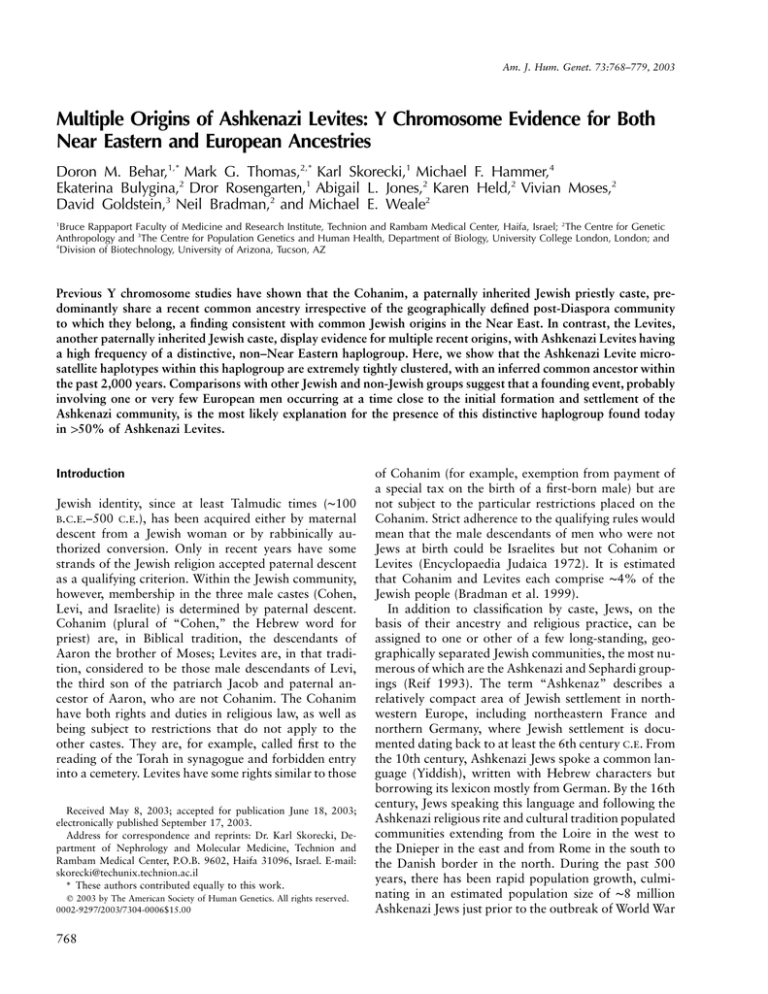
Am. J. Hum. Genet. 73:768–779, 2003
Multiple Origins of Ashkenazi Levites: Y Chromosome Evidence for Both
Near Eastern and European Ancestries
Doron M. Behar,1,* Mark G. Thomas,2,* Karl Skorecki,1 Michael F. Hammer,4
Ekaterina Bulygina,2 Dror Rosengarten,1 Abigail L. Jones,2 Karen Held,2 Vivian Moses,2
David Goldstein,3 Neil Bradman,2 and Michael E. Weale2
1
Bruce Rappaport Faculty of Medicine and Research Institute, Technion and Rambam Medical Center, Haifa, Israel; 2The Centre for Genetic
Anthropology and 3The Centre for Population Genetics and Human Health, Department of Biology, University College London, London; and
4
Division of Biotechnology, University of Arizona, Tucson, AZ
Previous Y chromosome studies have shown that the Cohanim, a paternally inherited Jewish priestly caste, predominantly share a recent common ancestry irrespective of the geographically defined post-Diaspora community
to which they belong, a finding consistent with common Jewish origins in the Near East. In contrast, the Levites,
another paternally inherited Jewish caste, display evidence for multiple recent origins, with Ashkenazi Levites having
a high frequency of a distinctive, non–Near Eastern haplogroup. Here, we show that the Ashkenazi Levite microsatellite haplotypes within this haplogroup are extremely tightly clustered, with an inferred common ancestor within
the past 2,000 years. Comparisons with other Jewish and non-Jewish groups suggest that a founding event, probably
involving one or very few European men occurring at a time close to the initial formation and settlement of the
Ashkenazi community, is the most likely explanation for the presence of this distinctive haplogroup found today
in 150% of Ashkenazi Levites.
Introduction
Jewish identity, since at least Talmudic times (∼100
B.C.E.–500 C.E.), has been acquired either by maternal
descent from a Jewish woman or by rabbinically authorized conversion. Only in recent years have some
strands of the Jewish religion accepted paternal descent
as a qualifying criterion. Within the Jewish community,
however, membership in the three male castes (Cohen,
Levi, and Israelite) is determined by paternal descent.
Cohanim (plural of “Cohen,” the Hebrew word for
priest) are, in Biblical tradition, the descendants of
Aaron the brother of Moses; Levites are, in that tradition, considered to be those male descendants of Levi,
the third son of the patriarch Jacob and paternal ancestor of Aaron, who are not Cohanim. The Cohanim
have both rights and duties in religious law, as well as
being subject to restrictions that do not apply to the
other castes. They are, for example, called first to the
reading of the Torah in synagogue and forbidden entry
into a cemetery. Levites have some rights similar to those
Received May 8, 2003; accepted for publication June 18, 2003;
electronically published September 17, 2003.
Address for correspondence and reprints: Dr. Karl Skorecki, Department of Nephrology and Molecular Medicine, Technion and
Rambam Medical Center, P.O.B. 9602, Haifa 31096, Israel. E-mail:
skorecki@techunix.technion.ac.il
* These authors contributed equally to this work.
䉷 2003 by The American Society of Human Genetics. All rights reserved.
0002-9297/2003/7304-0006$15.00
768
of Cohanim (for example, exemption from payment of
a special tax on the birth of a first-born male) but are
not subject to the particular restrictions placed on the
Cohanim. Strict adherence to the qualifying rules would
mean that the male descendants of men who were not
Jews at birth could be Israelites but not Cohanim or
Levites (Encyclopaedia Judaica 1972). It is estimated
that Cohanim and Levites each comprise ∼4% of the
Jewish people (Bradman et al. 1999).
In addition to classification by caste, Jews, on the
basis of their ancestry and religious practice, can be
assigned to one or other of a few long-standing, geographically separated Jewish communities, the most numerous of which are the Ashkenazi and Sephardi groupings (Reif 1993). The term “Ashkenaz” describes a
relatively compact area of Jewish settlement in northwestern Europe, including northeastern France and
northern Germany, where Jewish settlement is documented dating back to at least the 6th century C.E. From
the 10th century, Ashkenazi Jews spoke a common language (Yiddish), written with Hebrew characters but
borrowing its lexicon mostly from German. By the 16th
century, Jews speaking this language and following the
Ashkenazi religious rite and cultural tradition populated
communities extending from the Loire in the west to
the Dnieper in the east and from Rome in the south to
the Danish border in the north. During the past 500
years, there has been rapid population growth, culminating in an estimated population size of ∼8 million
Ashkenazi Jews just prior to the outbreak of World War
769
Behar et al.: Multiple Origins of Ashkenazi Levites
II. There is uncertainty concerning the relative contributions to Ashkenazi Jewry of, on one hand, western
versus eastern immigration of Jews and, on the other
hand, internally generated population growth versus
conversion to Judaism. In particular, it has been suggested that subjects of the Khazar Empire (located to
the northeast of the Black Sea), who had adopted Judaism in the last quarter of the first millennium C.E.,
were an important constituent of the nascent Ashkenazi
community (Encyclopaedia Judaica 1972).
The term “Sephardi” originally described Jews descended from the communities that existed in Spain
prior to the expulsion in 1492 C.E. However, current
usage applies this designation to all descendants of the
communities of North Africa and the Near East who
follow the Sephardi rite of worship and cultural traditions. It is thought that, prior to the middle of the
20th century, gene flow between the Ashkenazi and nonAshkenazi groups was relatively restricted.
The purported different modes of transmission of Levite and Cohen versus Israelite status provide a priori
expectations about patterns of genetic variation on the
paternally inherited nonrecombining region of the Y
chromosome (NRY). In particular, because of recent
shared ancestry, Cohanim and Levites would be expected to display lower gene diversity of NRY haplotypes than would Israelites. In addition, the distribution
of haplotype frequencies, in the absence of drift, should
be similar (a) in Cohanim and (b) in Levites across the
Ashkenazi-Sephardi division, given that this division occurred after the founding of these two groups.
In fact, previous studies have indeed shown that the
NRYs of Ashkenazi and Sephardi Cohanim are genetically more closely related to each other than they are
to the NRYs of Israelites or non-Jews (Skorecki et al.
1997; Thomas et al. 1998). This pattern arises primarily
from differences in the frequency of a particular NRY
haplotype (the Cohen Modal Haplotype [CMH], defined by six rapidly mutating microsatellites [Thomas
et al. 1998]), and a cluster of closely related haplotypes
within a single haplogroup (defined by slowly mutating
unique event polymorphisms [UEPs]). Chromosomes
belonging to this haplotype and its related cluster were
found at high frequency among Cohanim but at a much
lower frequency among Israelites. Furthermore, the pattern of diversity within the cluster was found to be consistent with descent from a common ancestor who lived
between 2,100 and 3,900 years ago. The CMH is also
found, at lower frequency, in non-Jewish populations
in the Near East, which would be consistent with its
origin in this geographic region. However, the same
studies found high frequencies of multiple haplogroups
in the Levites, indicating that no single recent origin
could be inferred for the majority of this group, despite
an oral tradition of a patrilineal descent similar to that
of the Cohanim. Moreover, a cluster of closely related
NRY haplotypes was identified within a distinctive
deep-rooting NRY clade that was found at much higher
frequency among Ashkenazi Levites than in either Sephardi Levites or any other Jewish group. However, the
reasons for this difference in the Ashkenazi Levites were
not explored.
Given the importance of the paternally defined Levite
caste in Jewish history and tradition, the multiple theories of the ethnogenesis of the Ashkenazi Jewish community, and a suggestion that Yiddish is a relexified
Slavic tongue (Wexler 1993), we undertook a detailed
investigation of the paternal genetic history of Ashkenazi Levites and compared the results with matching
data from neighboring populations among which the
Ashkenazi community lived during its formation and
subsequent demographic expansion. By analyzing NRY
haplotypes, we have revealed (a) a plausible historical
explanation for the multiple paternal histories of the
Levite caste, (b) the probable period during which a
European introgression into the caste took place, and
(c) the likely demographic scale of the event.
Subjects and Methods
Sampling
We analyzed NRY variation in a set of 988 unrelated
males from Ashkenazi Jews, Sephardi Jews, and four
non-Jewish European populations. Populations were
categorized using a combination of geographic, religious, and ethnohistorical criteria and individual affiliation within a category was determined according to
self-designation by the participant providing the sample.
Three of the four non-Jewish groups (88 Germans, 112
Sorbians, and 306 Belarusians) were chosen because of
their geographic location relative to the ancestral European communities of the Ashkenazi Jews, and also
because of prior knowledge of the geographic areas
known to have high frequencies of the NRY haplogroup
within which the distinctive Ashkenazi Levite high-frequency cluster was previously reported. This haplogroup
is designated “R1a1” according to the Y Chromosome
Consortium (2002). An additional non-Jewish group
consisting of 83 samples previously collected in Norway
(Weale et al. 2002) was chosen, to represent a geographic
location that excluded Jewish entry until the middle of
the 19th century and is known to be outside the area in
which Ashkenazi communities originated.
The Jewish samples comprised 236 Ashkenazi Jews
(AJ) and 163 Sephardi Jews, who were further divided
into 100 Ashkenazi Israelites (AI), 76 Ashkenazi Cohanim (AC), 60 Ashkenazi Levites (AL), 63 Sephardi
Israelites (SI), 69 Sephardi Cohanim (SC), and 31 Sephardi Levites (SL). The 60 AL samples were collected
770
from Ashkenazi males who identified themselves as Levites, with a paternal ancestry from one of the following
nine Ashkenazi Jewish communities; Austria-Hungary
(10), Belarus (4), France (6), Germany (10), Lithuania
(8), Netherlands (5), Poland (7), Romania (4), and Russia (6). Current political borders (including the current
borders of Austria and Hungary) were used to define
geographic origin. When the Ashkenazi Levite sample
was split into western (France, Netherlands, and Germany) versus eastern (all others) communities, no significant differences were found in haplogroup or haplotype frequencies (using the exact test of Raymond and
Rousset [1995]), but we note that the sample size is too
small to have power to detect anything other than very
large differences in frequency. Information regarding paternal lineage was collected from each of the participants. Paternal population affiliation was determined by
the oldest male-line ancestor that the participants identified, which extended back to at least the grandparental
level. The participants were not related through their
paternal lineages. The ethics review committees of
the participating institutions approved the sampling
protocols.
Am. J. Hum. Genet. 73:768–779, 2003
M13, M20, SRY10831, and SRY⫹465 as these markers distinguish haplogroups (taking other typed markers into
account) that are extremely rare in Europe and the Near
East (Underhill et al. 2000). In place of YAP, SRY4064, and
sY81, the German sample was typed for M35, as intermediate haplogroups (derived for YAP, ancestral for M35)
are, again, very rare in this part of the world.
Haplotypes.—We genotyped all samples for six STRs,
DYS19 (equivalent to DYS394), DYS388, DYS390,
DYS391, DYS392, and DYS393, according to protocols
previously reported by Thomas et al. (1999). In the
case of the Ashkenazi Levite samples, we also typed
six additional STRs (DYS385a, DYS385b, DYS389I,
DYS389II, DYS426, and DYS439), to allow more accurate estimation of the time to most recent common
ancestor (TMRCA). PCR primers and conditions for the
typing of the additional six STRs are as described by
Redd et al. (2002), multiplexes I and II. PCR products
were analyzed on ABI310 and ABI3100 DNA Analyzers,
and fragment lengths were converted to repeat numbers
by the use of allelic ladders. We define DYS389CD as
equivalent to DYS389I, and we define DYS389AB as
equivalent to DYS389II minus DYS389I (Rolf et al.
1998).
Genotyping
Haplogroups.—In all population samples except the
Ashkenazi Levites and Germans, we typed a set of 12
biallelic markers including one Alu insertion and 11 SNPs
to investigate the data reported herein. The 12 markers
were: 92R7, M9, M13, M17, M20, SRY⫹465, SRY4064,
SRY10831, sY81, Tat, YAP, and p12f2. PCR protocols for
detection of these polymorphisms have been reported
elsewhere (Thomas et al. 1999; Rosser et al. 2000).
These 12 markers give rise to the following 10 observed
haplogroups, labeled according to the Y Chromosome
Consortium (2002) nomenclature: Y*(xBR,A3b2),
BR*(xDE,JR), E*(xE3a), J, K*(xL,N3,O2b,P), L, N3,
P*(xR1a), R1a*, and R1a1. We note that one of these is
a very rare haplogroup (R1a*) that has previously been
observed only in two Armenian men (Weale et al. 2001).
We now report the same haplogroup in one additional
Belarusian man. The Ashkenazi Levites were typed for a
set of 25 biallelic markers including P9, M216, M217,
YAP, P2, M35, P14, M201, P15, M52, P19, 12f2b,
M172, M9, M20, LLY22g, Tat, M175, P27, P36, M207,
M173, SRY10831, M17, and P25. PCR protocols for detection of these polymorphisms have been reported elsewhere (Hammer et al. 2001; Underhill et al. 2001). This
set of biallelic markers allowed the designation of the
Ashkenazi Levite chromosomes into the same 10 observed
haplogroups. The exact labeling of the Ashkenazi Levite
haplogroups, by use of all 25 biallelic markers, is reported
in table A (online only). The German data are reported
elsewhere (Capelli et al. 2003) and were not typed for
Statistical Analysis
Estimation of Time to Most Recent Common Ancestor.—If the root haplotype is known, central estimates
can be obtained of the TMRCA that are independent of
population demography and shape of the genealogy and
are dependent only on the mutation model assumed
(Stumpf and Goldstein 2001). We obtained central estimates of the TMRCA under two models of microsatellite mutation. Under the simple stepwise mutation
model (S-SMM), mutation rate is independent of microsatellite repeat number and mutations are equally
likely to result in an increase or decrease in length. It
ˆ p D/m̄
¯ is an unbiased estimator of
can be shown that T
the TMRCA (in generations), where D̄ is the average
squared difference in repeat length between each sampled NRY and the root haplotype, averaged over loci,
and m̄ is the S-SMM mutation rate (per generation) averaged over loci (Goldstein et al. 1995a, 1995b; Slatkin
1995). Locus-specific estimates of mutation rates are currently hampered by lack of data, so we chose to estimate
a common mutation rate by combining data on all triand tetra-nucleotide NRY microsatellites for which direct data (including mean repeat sizes) are available.
Combining the pedigree-based data of Bianchi et al.
(1998), Forster et al. (1998), Heyer et al. (1997), and
Kayser et al. (2000) leads to an estimate of m¯ p
18/9347 p 0.00193. A more recent pedigree-based
study estimated a higher mutation rate of 0.0042 for the
same 12 STRs as were used for the Ashkenazi Levites
771
Behar et al.: Multiple Origins of Ashkenazi Levites
(Bonne-Tamir et al. 2003), as did a study based on mutational analysis of single sperm cells (Holtkemper et al.
2001). In contrast, some other studies based on dating
deep-rooting Y chromosome clades have suggested
lower “evolutionary” mutation rates (Caglia et al. 1997;
Forster et al. 2000). These considerations introduce additional uncertainty in the true value of m̄ for our loci
(Zhivotovsky et al. 2001). We allowed for some uncertainty in m̄ when calculating confidence limits for the
TMRCA, and we note that the length-dependent model
described below may also accommodate some locus-specific variation in mutation rate (Carvalho-Silva et al.
1999). Two microsatellite loci typed in our study,
DYS385a and DYS385b, are homologous, so that reported repeat lengths cannot be assigned unambiguously
to this locus. This problem is overcome by adding the
two repeat lengths together and treating this as a single
“locus” with a mutation rate of 2m.
The second microsatellite mutation model we used
was a linear length dependent stepwise mutation model
(LLD-SMM). Under this model, motivated by a proportional slippage mutation mechanism, the mutation
rate is determined by the linear equation m p a ⫹ bL,
where L is the current repeat size. Length-dependency
has been proposed as one possible explanation for large
inter-locus variability in Y chromosome microsatellites
ˆ p D/m̄
¯ 0 is
(Forster et al. 2000). It can be shown that T
an unbiased estimator of the TMRCA, where D̄ is as
defined above and m̄0 is the mutation rate for the root
haplotype, averaged over loci (Calabrese et al. 2001).
Again, due to limited data we assume common values
for a and b over all loci, and use the estimates reported
by Stumpf and Goldstein (2001), anchored by assuming
m p 0.00193 when L p 15.77 (from the direct data,
described above, of Bianchi et al. [1998], Forster et al.
[1998], Heyer et al. [1997], and Kayser et al. [2000]).
This results in estimates of a p ⫺4.03 # 10⫺3 and
b p 3.78 # 10⫺4. The two homologous loci DYS385a
and DYS385b were accommodated by adding their repeat lengths together into a single value of L and treating
them as a single “locus” with m p 2a ⫹ bL. If negative
values of m were produced, these were treated as zero.
Unlike the central estimates, CIs on the TMRCA are
dependent on population demography, regardless of the
mutation model used. These were found by Monte Carlo
simulation, using a coalescent-with-exponential-growth
model scaled in units of the TMRCA, incorporating uncertainty in mutation rate, and implemented in the program Ytime.
Estimation of genetic diversity and distance.—Genetic
diversity was measured using Nei’s unbiased h statistic
(Nei 1987). Tests for population differentiation were
performed using the exact test of Raymond and Rousset
(1995). Two common measures of genetic distance are
FST (Reynolds et al. 1983) and 1⫺I, where I is Nei’s
Genetic Identity. We found a poor correlation between
FST and 1⫺I for the population samples analyzed in this
study (r p 0.383 among the 10 population data sets
using haplotype frequencies and using all 45 pairwise
combinations). We propose that 1⫺I is a better measure
of genetic distance (in the sense of a metric summarizing
useful aspects of interpopulation differences in gene frequency), for comparisons among populations where recent admixture is a likely demographic model. This is
because if two different populations A and B admix to
form a population C, the expected immediate I value
between C and either A or B is dependent only on the
admixture proportion between A and B, the I value between A and B, and the relative gene diversities (via the
ratio (1 ⫺ hA)/(1 ⫺ hB )), whereas the expected FST value
is dependent not only on these factors but also on the
absolute diversities of A and B. This results in an unwanted dependency of FST on the absolute gene diversities of A and B (FST is larger when the gene diversities
are smaller, because FST is a measure of between-population diversity divided by the sum of between- and
within-population diversities). This unwanted dependency is avoided by the use of 1⫺I. We note that the
same arguments apply to Nei’s Genetic Distance, D p
⫺ log (I), as to 1⫺I, since there is a monotonic relationship between the two. We found the same conclusions
when we analyzed our data using D as we did using
1⫺I.
Visualization of genetic-distance patterns.—We visualized patterns of genetic differentiation using Principal
Coordinates Analysis, performed on I to form the similarity matrix. Values along the main diagonal of the
similarity matrix, representing the similarity of each population sample to itself, were calculated from the estimated genetic distance between two copies of the same
population sample (for I values, the resulting self-similarity values simplify to n/(n ⫺ 1) , where n is the sample
size).
Results
The haplogroup frequencies found in the six Jewish and
four non-Jewish data sets are shown in table 1. The table
confirms the presence of R1a1 as the modal haplogroup
in the Ashkenazi Levite Jews (52% of chromosomes).
This haplogroup is found at similarly high frequencies
in the two Slavonic-speaking populations (Sorbians and
Belarusians), but at a maximum frequency of only 5.8%
among the other five Jewish data sets (mean frequency
3.2%). Pairwise genetic similarities (Nei’s genetic identity I) and P values for population differentiation at the
haplogroup level are shown in table 2, and figure 1 displays the principal coordinates plot derived from the
genetic similarity values. Figure 1 reflects the unusual
distribution of Ashkenazi Levite haplogroup frequencies.
772
Am. J. Hum. Genet. 73:768–779, 2003
Table 1
Haplogroup Frequencies across Six Jewish and Four Non-Jewish Sample Sets
FREQUENCY
HAPLOGROUP
Y*(xBR,A3b2)
BR*(xDE,JR)
E*(xE3a)
J
K*(xL,N3,O2b,P)
L
N3
P*(xR1a)
R1a*
R1a1
IN
SAMPLE SETa
AC
(n p 76)
SC
(n p 69)
AL
(n p 60)
SL
(n p 31)
AI
(n p 100)
SI
(n p 63)
Ger
(n p 88)
Nor
(n p 83)
Sorb
(n p 112)
Bel
(n p 306)
…
.0263
.0395
.8684
.0263
…
…
.0263
…
.0132
…
.0290
.0435
.7536
.0290
…
…
.0870
…
.0580
…
.0333
.2000
.1000
.0333
…
…
.1167
…
.5167
…
.1935
.0968
.3226
.2258
.0323
…
.0968
…
.0323
…
.1400
.2200
.3700
.0800
…
…
.1500
…
.0400
.0159
.0794
.1905
.3651
.1270
…
…
.2063
…
.0159
…
.3295
.0341
.0341
…
…
.0114
.4659
…
.1250
…
.4458
.0120
.0241
…
…
.0361
.2651
…
.2169
…
.1786
.0625
.0268
…
…
.0089
.0893
…
.6339
…
.2582
.0458
.0327
.0033
…
.1046
.0425
.0033
.5098
a
Population sample labels: AC p Ashkenazi Cohen; SC p Sephardi Cohen; AL p Ashkenazi Levite; SL p Sephardi Levite; AI p Askenazi
Israelite; SI p Sephardi Israelite; Ger p German; Sorb p Sorb; Bel p Belarusian; Nor p Norwegian.
The other Jewish data sets separate according to whether
they are Cohanim or non-Cohanim, and, within these
two groups, there are no significant differences between
Ashkenazi and Sephardi data sets (all tests for population differentiation performed using the exact test of
Raymond and Rousset (1995). The genetic similarities
among these five Jewish data sets range from 0.79 to
1.0. In contrast, the Ashkenazi Levites cluster more with
the Slavonic data sets than they do with the other Jewish
data sets. The genetic similarities with the other Jewish
data sets range from 0.22 to 0.47, whereas the I values
with the Sorbian and Belarusian data sets are 0.95 and
0.88, respectively. When a bootstrap test is used, the I
value for Ashkenazi Levites with Sorbians and Belarusians is, in both cases, significantly higher than the I
value for Ashkenazi Levites with Sephardi Israelites, the
most similar Jewish data set to the Ashkenazi Levites
(P p .004 for Sorbians and .008 for Belarusians).
At the haplotype level (combining UEP information
with the six microsatellite loci), significant differences
in haplotype frequency emerge between all data sets
(table 3), but the same underlying patterns of similarity
remain (fig. 2). Full haplotype information for all data
sets is available in supplemental tables A and B (online
only). The genetic similarities between the Ashkenazi
Levites and the other Jewish data sets range from 0.04
to 0.18, whereas the I values with the Sorbian and Belarusian data sets are 0.52 and 0.49 respectively. Using
a bootstrap test, the I value for Ashkenazi Levites with
Sorbians and Belarusians is again significantly higher in
both cases than the corresponding I value for Ashkenazi
Levites with their most similar Jewish group, the Ashkenazi Israelites (P p .006 for Sorbians and .004 for
Belarusians).
Within haplogroup R1a1, the microsatellite haplotypes found in the AL data set are tightly clustered
around a modal haplotype (16-12-25-10-11-13) that
comprises 74% of Ashkenazi Levites within this haplogroup, and 38% of Ashkenazi Levites overall (table
4). This modal haplotype is evenly distributed across
the geographically defined communities from which the
Ashkenazi Levite sample was taken (see the “Subjects
and Methods” section and table A), so that clues to its
origin could not be found from these data. The very
high frequency of this modal haplotype makes the genetic diversity of Ashkenazi Levite NRYs within the
R1a1 haplogroup much lower than in the non-Jewish
comparative data sets in which R1a1 is found at high
frequency (table 5). Bootstrap tests indicate that, within
R1a1, h is significantly lower in AL than in the Sorbian,
Belarusian, and Norwegian data sets (P ! .001 in each
case). The P value for the comparison with the German
data set is of borderline significance (P p .064), but the
number of R1a1 chromosomes within this data set is
small (n p 11), resulting in a larger sampling variance.
The additional six microsatellites genotyped for Ashkenazi Levites only reduce the modal haplotype frequency within the R1a1 haplogroup to 58%, also confirming the high degree of haplotype homogeneity (table
6). As is explained in the “Discussion” section, this arrangement of R1a1 haplotypes within the Ashkenazi
Levite data set is consistent with common descent from
a recent ancestor and is unlikely to have resulted from
a large number of founding lineages. By assuming that
the most recent common ancestor (MRCA) possessed
the modal haplotype and by using a male intergeneration time of 25 years, we estimated a mean TMRCA of
663 years before present under the Simple Stepwise Mutation Model and a mean time of 1,000 years before
present under the Linear Length-Dependent Stepwise
Mutation Model (see the “Subjects and Methods” section). These dates coincide with the historically estimated time when compact settlements of Jews in
northwest Europe began and the important religious
773
Behar et al.: Multiple Origins of Ashkenazi Levites
communities of Mainz and Worms were established
(Encyclopaedia Judaica 1972), but they also come with
very wide CIs. If we assume a genealogy generated under
no population growth, the 95% CIs are 0–2,425 years
before present under the simple stepwise mutation
model, and 0–3,672 years before present under the linear length-dependent stepwise mutation model. However, the Ashkenazi Jewish population has undergone
rapid population growth in the past 1,000 years, estimated at a 17.5% growth rate per generation in the
Ashkenazi Jewish population over this period (DellaPergola 2001). The starlike pattern for the R1a1 haplotypes for AL is consistent with this pattern of population expansion for the Ashkenazi Jewish population
in general. By use of this estimate of 17.5% for growth
and under the assumption of 4.5 million male Ashkenazi
Jews in 1939, a 1:5 ratio of effective population size
to census population size due to reproductive variance
and the fact that Ashkenazi Levites make up 4% of
Ashkenazi Jews, the 95% CI is reduced substantially to
244–1,570 years before present (BP) under the simple
stepwise mutation model, and 375–2,248 years BP under the linear length-dependent stepwise mutation
model. It should be noted that our estimations of the
TMRCA rely on pedigree mutation rates. It has been
argued that “evolutionary” mutational rates may occur
at a lower rate (Caglia et al. 1997; Forster et al. 2000).
If so, the TMRCA is underestimated by our method.
On the other hand, if our assumption of a single founder
is false, then the TMRCA of this clade would overestimate the founding event. An alternative method for
dating the founding event, again under the assumption
of a single founder, derives from consideration of the
fact that it is easier to affect a large frequency change
in the Ashkenazi Levite male gene pool when it is small
than when it is large. We allowed for a possible initial
reproductive advantage to the founder—for example,
Figure 1
Principal coordinates plot of the genetic identity values
(haplogroup level) shown in table 2. Axis labels indicate the percentage
explained by the first two principal axes.
due to elevated wealth or status—such that he contributed, at most, 100 grandsons to the Ashkenazi Levite
population (i.e., 20 grandsons to the effective population size, under the assumption of a 1:5 ratio, as above),
after which time the differential reproductive fitness was
lost. As above, we assumed a general Ashkenazi Levite
growth rate of 17.5% per generation and an Ashkenazi
Levite effective population size of 36,000 in 1939.
Performing coalescent simulations with exponential
growth, we found that the 20 grandsons needed to be
added at least 35 generations ago to provide a chance
of 15% that 31 of 60 modern Ashkenazi Levites sampled would descend from this founding group. Under
Table 2
Pairwise Comparisons at Haplogroup Level among Six Jewish and Four Non-Jewish Sample
Sets
AC
SC
AL
SL
AI
SI
Ger
Nor
Sorb
Bel
AC
SC
AL
SL
AI
SI
Ger
Nor
Sorb
Bel
…
1.002
.216
.793
.821
.819
.106
.089
.071
.089
.407
…
.293
.821
.856
.860
.192
.159
.144
.152
!.001
!.001
!.001
!.001
!.001
!.001
!.001
!.001
!.001
!.001
!.001
…
.977
.983
.507
.531
.273
.342
.111
…
1.021
.510
.461
.276
.307
.200
.548
…
.523
.398
.205
.212
!.001
!.001
!.001
!.001
!.001
!.001
!.001
!.001
!.001
!.001
!.001
!.001
…
.927
.475
.510
.048
…
.656
.745
!.001
!.001
!.001
!.001
!.001
!.001
!.001
!.001
!.001
!.001
!.001
!.001
!.001
!.001
!.001
!.001
…
.975
.002
…
…
.381
.468
.425
.426
.515
.953
.875
NOTE.—Lower left triangle p Nei’s Genetic Identity, I; upper right triangle p P values for
population differentiation (exact test of Raymond and Rousset 1995), uncorrected for multiple
pairwise comparisons. Population sample labels are the same as in table 1.
774
Am. J. Hum. Genet. 73:768–779, 2003
the assumption of a male intergeneration time of 25
years, this implies an original founding event that occurred at least 990 years BP (925 years before 1939).
Taken together, these separate time estimates provide a
timeframe that coincides with the initial formation and
early settlement of the Ashkenazi Jewish population.
Finally, we used the same growth model to investigate
how many males could have moved into the Ashkenazi
Levite population at the same time as the founder and
yet have at least a 5% chance of leaving no descendents
in a sample of 60 Ashkenazi Levites today. Because we
allow for a potentially very small effective population
size, it is possible for an introgression to comprise a
sizeable proportion of the Ashkenazi Levite NRY gene
pool at the time and yet correspond to only a relatively
small number of individuals. If the event took place 37
generations before 1939 (990 years BP), such “silent”
introgressors could have made up as much as 19% of
the Ashkenazi Levite gene pool, equivalent to an addition of 50 men to the existing Ashkenazi Levite population. The corresponding figures for 45 generations
before 1939 (1,190 years BP) and 55 generations before
1939 (1,440 years BP) are 53% (33 men) and 94% (10
men).
Figure 2
Principal coordinates plot of the genetic identity values
(haplotype level) shown in table 4. Axis labels indicate the percentage
explained by the first two principal axes.
Discussion
Our study confirms the previously reported finding of a
caste-specific high-frequency haplogroup within the
Ashkenazi Levites (Thomas et al. 1998). The presence
of this haplogroup, R1a1, within Ashkenazi Levites is
striking for several reasons. Firstly, it is found at high
frequency in the Ashkenazi Levites but not in Sephardi
Levites or any other Jewish grouping examined so far.
This means that in paternal ancestry Ashkenazi and Sephardi Levites are genetically dissimilar, unlike Ashkenazi and Sephardi Cohanim (fig. 1). The Ashkenazi and
Sephardi Israelites are also relatively similar to each
other, which is consistent with the previous reports of
shared overall paternal Near Eastern ancestries for these
populations (Hammer et al. 2000; Nebel et al. 2000).
Secondly, the microsatellite haplotypes within this haplogroup form a tight cluster within the Ashkenazi Levites, indicative of very recent origin from a single common ancestor. Thirdly, the haplogroup is extremely rare
in other Jewish groups and in non-Jewish groups of Near
Eastern origin, but is found at high frequency in populations of eastern European origin. This contrasts with
Table 3
Pairwise Comparisons at Haplotype Level among Six Jewish and Four Non-Jewish Sample
Sets
AC
SC
AL
SL
AI
SI
Ger
Nor
Sorb
Bel
AC
SC
AL
SL
AI
SI
Ger
Nor
Sorb
Bel
…
.945
.060
.349
.723
.711
.019
.067
.087
.028
!.001
!.001
!.001
!.001
!.001
!.001
!.001
!.001
!.001
!.001
!.001
!.001
…
.421
.491
.198
.138
.104
.056
.002
…
.807
.152
.131
.191
.201
.028
.004
…
.179
.215
.160
.081
!.001
!.001
!.001
!.001
!.001
!.001
!.001
!.001
!.001
!.001
!.001
!.001
…
.799
.295
.332
.036
…
.334
.334
!.001
!.001
!.001
!.001
!.001
!.001
!.001
!.001
!.001
!.001
!.001
!.001
!.001
!.001
!.001
!.001
!.001
…
.081
.335
.765
.766
.028
.075
.096
.076
…
.040
.181
.126
.028
.101
.525
.490
…
.613
…
NOTE.—Lower left triangle p Nei’s Genetic Identity, I; upper right triangle p P values for
population differentiation (exact test of Raymond and Rousset 1995), uncorrected for multiple
pairwise comparisons. Population sample labels are the same as in table 1.
775
Behar et al.: Multiple Origins of Ashkenazi Levites
Table 4
Microsatellite Haplotype Frequencies within Haplogroup R1a1 across Six Jewish and Four Non-Jewish Sample
Sets
FREQUENCY
MICROSATELLITE
HAPLOTYPEa
14
15
15
15
15
15
15
15
15
15
15
15
15
16
16
16
16
16
16
16
16
16
16
16
16
16
16
16
16
16
16
17
17
17
17
17
17
17
17
17
17
17
17
17
17
17
12
12
12
12
12
12
12
12
12
12
13
13
14
11
12
12
12
12
12
12
12
12
12
12
12
12
12
12
13
13
13
10
12
12
12
12
12
12
12
12
12
12
12
13
13
13
25
24
24
24
25
25
25
25
26
26
25
25
25
24
24
24
24
24
24
25
25
25
25
25
25
25
26
26
25
25
25
24
23
24
24
24
25
25
25
25
25
26
26
25
25
26
10
10
10
11
10
10
11
11
10
11
10
11
11
11
10
10
10
10
11
10
10
11
11
11
11
12
10
11
10
10
11
10
11
10
10
11
10
10
10
10
11
10
10
10
11
11
11
11
11
11
11
12
11
11
11
11
13
11
11
11
11
11
11
12
11
11
11
11
11
11
12
11
11
11
11
11
11
11
11
11
11
11
11
11
11
12
11
11
12
11
11
11
13
12
13
13
13
13
13
14
13
13
13
13
13
14
12
13
14
13
13
12
13
12
13
14
13
13
13
13
13
15
14
13
14
13
14
13
12
13
14
13
13
13
13
13
13
13
IN
SAMPLE SET
AC
SC
AL
SL
AI
SI
Ger
Nor
Sorb
Bel
…
…
…
…
.0132
…
…
…
…
…
…
…
…
…
…
…
…
…
…
…
…
…
…
…
…
…
…
…
…
…
…
…
…
…
…
…
…
…
…
…
…
…
…
…
…
…
…
…
…
…
…
…
…
…
…
…
…
…
…
…
…
…
…
…
.0145
…
.0145
…
.0290
…
…
…
…
…
…
…
…
…
…
…
…
…
…
…
…
…
…
…
…
…
…
…
…
…
.0333
…
.0333
…
…
…
…
…
…
…
…
…
.0167
.0167
…
…
…
…
.3833
…
…
…
…
…
…
…
…
…
…
…
…
.0167
…
…
…
.0167
…
…
…
…
…
…
…
…
…
…
…
…
.0323
…
…
…
…
…
…
…
…
…
…
…
…
…
…
…
…
…
…
…
…
…
…
…
…
…
…
…
…
…
…
…
…
…
…
…
…
…
…
…
…
…
…
…
…
…
.0100
…
…
…
…
…
…
…
…
…
…
…
…
…
…
…
.0100
…
.0200
…
…
…
…
…
…
…
…
…
…
…
…
…
…
…
…
…
…
…
…
…
…
…
…
…
…
…
…
…
…
…
…
…
…
…
…
…
…
.0159
…
…
…
…
…
…
…
…
…
…
…
…
…
…
…
…
…
…
…
…
…
…
…
…
…
…
…
…
…
…
…
…
…
…
.0114
…
…
.0114
…
…
…
…
…
…
…
…
…
…
…
.0114
…
…
.0568
…
…
…
…
…
…
…
…
…
…
.0114
…
…
…
.0114
…
…
…
.0114
…
…
…
…
…
…
…
.0120
.0482
…
.0241
.0120
…
.0241
…
…
.0120
…
…
.0120
…
…
…
…
.0120
…
.0361
…
…
…
…
…
…
…
…
.0120
.0120
…
…
…
…
…
…
…
…
…
…
…
…
…
…
…
…
.0179
.0536
…
.0089
…
…
…
…
.0089
…
…
…
.0893
…
…
…
…
.1071
…
.0179
…
…
…
.0089
.0089
…
…
…
…
…
.0268
.0089
.0089
.0089
.1786
…
.0089
.0357
.0268
…
…
…
.0089
.0033
.0033
.0098
.0098
.0294
.0065
.0458
…
.0065
.0065
.0033
…
…
.0033
…
.0131
.0065
.0033
.0229
…
.0850
.0065
.1209
.0033
.0065
.0033
…
.0131
.0163
.0033
.0033
…
…
.0033
…
…
…
.0425
.0033
…
.0131
.0033
.0033
.0033
.0033
…
NOTE.—Population sample labels are the same as in table 1.
a
Composed of the repeat sizes of microsatellite loci, in the following order: DYS19, DYS388, DYS390, DYS391,
DYS392, DYS393.
the Cohen Modal Haplotype, for example, which belongs to a haplogroup that is more likely to be of Near
Eastern origin. Finally, the haplogroup represents ∼50%
of all Ashkenazi Levite NRYs, which indicates that, as
a group, the Ashkenazi Levites have heterogeneous or-
igins in comparison with the Cohanim, who are dominated by a single haplogroup and whose origins are consistent with an event antedating the Diaspora.
The greatly elevated frequency of haplogroup R1a1
only within the Ashkenazi Levites suggests an event spe-
776
Am. J. Hum. Genet. 73:768–779, 2003
Table 5
Sample Size and Microsatellaite Diversity within Haplogroup R1a1
VALUE
IN
SAMPLE SET
VARIABLE
AC
SC
AL
SL
AI
SI
Ger
Nor
Sorb
Bel
No. of Subjects in R1a1 Haplogroup
Haplotype Diversitya
SE for Haplotype Diversity
1
…
…
4
…
…
31
.4516
.1097
1
…
…
4
…
…
1
…
…
11
.8182
.1191
18
.9281
.0401
71
.86721
.0245
156
.896
.0142
a
By use of the unbiased gene diversity formula (Nei 1987), for cases where n 1 10.
cific to the Ashkenazi Levites. This is borne out by the
fact that the haplogroup is virtually absent from the
Sephardi Levites, which would indicate an event that
occurred after the separate formation of the Ashkenazi
and Sephardi groupings, and also by the very recent
inferred date for the common ancestor of the NRYs
within this haplogroup in the Ashkenazi Levites, which
also supports an event occurring after the Ashkenazi
split from other Jewish populations.
The pattern of microsatellite haplotype diversity
within haplogroup R1a1 in the Ashkenazi Levites suggests that any founding event is unlikely to have involved a large number of founding lineages contributing
to today’s Ashkenazi Levite NRY gene pool. If large
numbers were involved, then the lack of microsatellite
diversity would imply that all the founding lineages
were very closely related to each other. Furthermore,
under this scenario the microsatellite diversity seen today would partly result from diversity among the founding lineages, in which case the evidence would suggest
a founding event even more recent than that estimated
above, under the assumption of a single founding individual. Although a more recent event is not impossible, the current range of estimated dates fits very nicely
with the known origins of the Ashkenazi, a time when
the estimated population size was small and which
would therefore make it easier for the descendents of a
single founder to expand to high frequency within the
population, as our simulations demonstrate. Furthermore, if there had been a large influx of founder lineages, the haplotype frequency distribution of the source
population would be expected to match the haplotype
frequency distribution found in Ashkenazi Levites today. Such a matching source population has yet to be
identified. In the case of the two non-Jewish populations
of Eastern European origin examined in this study, neither the Sorbians nor the Belarusians would be suitable
candidates. This is because, in both cases, the modal
haplotype within haplogroup R1a1 for the Sorbians and
the Belarusians is either completely absent or found only
as a singleton within the Ashkenazi Levite sample (table
4).
Although the number of founding lineages contributing to the current Ashkenazi Levite NRY gene pool
appears to be small and could involve only a single
founding male, it is possible that the founding event
also coincided with a larger introgression event but subsequent drift led to the loss of these other lineages from
the NRY gene pool. Our simulations suggest that up to
50 men could have been involved in such an event. This
result assumes a 5:1 ratio of real:effective population
size, and there are processes that could make this ratio
even more pronounced (see, for example, the work of
Gagnon and Heyer [2001]). However, this would result
in such small effective population sizes and so much
resultant drift that one would not expect to find the
close NRY genetic similarity observed between Ashkenazi and Sephardi Cohanim, who make up a percentage
of the Jewish population very similar to the Levites’.
Two further arguments against a recent large introgression of non-Jews into the Ashkenazi Levite caste
are: (a) it would have to breach a well-regulated rabbinically controlled barrier, and (b) it would most likely
leave some prominent trace in the historical record—
which it has not.
For the reasons stated above, it is likely that the event
leading to a high frequency of R1a1 NRYs within the
Ashkenazi Levites involved very few, and possibly only
one, founding father. A question, then, arises regarding
the possible origins of the founder(s). Haplogroup R1a1
is found at very low frequency in other Jewish groups
(table 1). It is possible, therefore, that this haplogroup
was also present at very low frequency in the Ashkenazi
Levites, before some event specific to the Ashkenazi Levites occurred that led to a founder who, by chance,
had this very rare haplogroup and whose descendents
became very numerous within the Ashkenazi Levites.
Likewise, the haplogroup is also found at very low frequency within some non-Jewish populations of Near
Eastern origin (data not shown). It is therefore also possible that a conversion event prior to the formation of
the Ashkenazi grouping led to the founding of this haplogroup and its emergence at high frequency within the
Ashkenazi Levites. Although it is not possible to formally refute either of these two possible explanations,
it would be a remarkable coincidence that the geographic origins and demographic expansion of the Ashkenazi are within Northern and Eastern Europe and that
this haplogroup is found at very high frequency within
neighboring non-Jewish populations of European origin
777
Behar et al.: Multiple Origins of Ashkenazi Levites
Table 6
Microsatellite Haplotype Frequencies within Haplogroup R1a1 for 12 Microsatellites
Typed in the Ashkenazi Levite Sample
Count
Frequency in
Haplogroup
Frequency
in Sample
24 10 11 13 12 14]
2
.0645
.0333
25 10 11 13 12 14]
25 10 11 13 12 14]
1
1
.0323
.0323
.0167
.0167
24 10 11 12 12 14]
1
.0323
.0167
24 10 11 13 12 14]
1
.0323
.0167
25 10 11 13 12 14]
25 10 11 13 12 14]
25 10 11 13 12 14]
4
1
18
.1290
.0323
.5806
.0667
.0167
.3000
24 10 11 13 12 14]
1
.0323
.0167
25 10 11 13 12 14]
1
.0323
.0167
6-Locusa and Constituent 12-Locusb Haplotypes
15 12 24 10 11 13:
[15 11 14 12 13 17
15 12 25 10 11 13:
[15 11 14 12 13 17
[15 11 14 12 13 16
16 12 24 10 11 12:
[16 11 14 12 13 18
16 12 24 10 11 13:
[16 11 14 12 13 17
16 12 25 10 11 13:
[16 11 14 12 13 16
[16 11 14 12 13 18
[16 11 14 12 13 17
17 12 24 10 11 13:
[17 11 14 12 13 17
17 12 25 10 11 13:
[17 11 14 12 13 17
a
Composed of the repeat sizes of microsatellite loci, in the following order: DYS19,
DYS388, DYS390, DYS391, DYS392, DYS393.
b
Shown in brackets and composed of the repeat sizes of microsatellite loci, in the
following order: DYS19, DYS385a, DYS385b (arbitrarily given larger repeat size over
DYS385a), DYS388, DYS389-I, DYS389-II, DYS390, DYS391, DYS392, DYS393,
DYS426, DYS439.
but not at high frequency elsewhere. An alternative explanation, therefore, would postulate a founder(s) of
non-Jewish European ancestry, whose descendents were
able to assume Levite status.
If a European origin for the Ashkenazi Levite haplogroup R1a1 component is accepted as a reasonable
possibility, it is of interest to speculate further on the
possible timing, location, and mechanism of this event.
Because the modal haplotype of haplogroup R1a1
found in the Ashkenazi Levites is found at reasonably
high frequency throughout the eastern European region,
it is not possible to use genetic information to pinpoint
the exact origin of any putative founder from the currently available data sets. Intriguingly, the Sorbian
tongue, relexified with a German vocabulary, has been
proposed as the origin of Yiddish, the language of the
Ashkenazim, but there has been no suggestion of an
association between Ashkenazi Levites in particular and
the Sorbian language. One attractive source would be
the Khazarian Kingdom, whose ruling class is thought
to have converted to Judaism in the 8th or 9th century
(Dunlop 1967). This kingdom flourished between the
years 700 C.E. and 1016 C.E. It extended from northern
Georgia in the south to Bulgar on the Volga River in
the north and from the Aral Sea in the east to the Dnieper River in the west—an area that falls within a region
in which haplogroup R1a1 NRYs are found at high
frequency (Rosser et al. 2000). Archival material also
records migration of Khazars into the Hungarian Duchy
of Taskony in the 10th century. The break-up of the
Khazar Empire following their defeat by invading Rus
led to the flight of some Khazars to central and northern
Europe. Although neither the NRY haplogroup composition of the majority of Ashkenazi Jews nor the microsatellite haplotype composition of the R1a1 haplogroup within Ashkenazi Levites is consistent with a
major Khazar or other European origin, as has been
speculated by some authors (Baron 1957; Dunlop 1967;
Ben-Sasson 1976; Keys 1999), one cannot rule out the
important contribution of a single or a few founders
among contemporary Ashkenazi Levites.
Finally, it is interesting to speculate on the possible
mechanism by which the descendant of a non-Jew or
convert could have acquired Levite status. The fact that
Ashkenazi Cohanim NRYs show no evidence for an
introgression of this nature suggests a lesser degree of
stringency for the assumption of Levite status than for
the assumption of Cohen status. This may be because
there are more rights and duties associated with the
Cohen status than with that of the Levite, leading to
more rigorous protection of the former. Cohanim, for
example, are called upon, on special occasions, to bless
the assembled congregation and are prohibited from
marrying divorcees and converts, religious laws that do
not apply to Levites. Indeed, Talmudic sources may possibly be interpreted to support the notion of differences
778
in the social, religious, and legal barriers that relate to
the assumption of Cohen and Levite status. These include descriptions of the possible assumption of Levite
status other than through patrilineal descent, in a Talmudic passage describing a debate regarding the potential assignment of Levite status to a man (and his descendants) whose father was a non-Jew and whose
mother was the daughter of a Levite. Such differences
could have provided the backdrop for the sanctioned
acceptance of Levite status other than through patrilineal descent.
The comparative study of patterns of NRY variation
among Ashkenazi Jews and other populations has revealed evidence for an unexpected and unusual historical event, which was not appreciated using other, more
conventional historical approaches. This finding may
motivate historians and social scientists to seek further
information regarding the possibility of such an event
and, more generally, to include information gleaned
from studies of DNA variation in the repertoire of tools
used to uncover historical events of interest.
Acknowledgments
We wish to express our gratitude to the individuals who
very kindly provided samples for this study. We thank M. A.
Strøksnes, for help in sampling; C. Capelli, for generously providing data prior to publication; and Y. Weiner, for helpful
input.
Electronic-Database Information
Accession numbers and URLs for data presented herein are
as follows:
Ytime program, http://www.ucl.ac.uk/tcga/software/
References
Baron SW (1957) A social and religious history of the Jews.
Vol. III. The Jewish Publication Society of America, Philadelphia, pp 173–222
Ben-Sasson HH (1976) Jewish autonomy from the Black Death
to the Reformation. In: Ben-Sasson HH (ed) A history of
the Jewish people. Harvard University Press, Cambridge,
MA, pp 593–611
Bianchi NO, Catanesi CI, Bailliet G, Martinez-Marignac VL,
Bravi CM, Vidal-Rioja LB, Herrera RJ, Lopez-Camelo JS
(1998) Characterization of ancestral and derived Y-chromosome haplotypes of New World native populations. Am
J Hum Genet 63:1862–1871
Bonne-Tamir B, Korostishevsky M, Redd AJ, Pel-Or Y, Kaplan
ME, Hammer MF (2003) Maternal and paternal lineages of
the samaritan isolate: mutation rates and time to most recent
common male ancestor. Ann Hum Genet 67:153–164
Bradman N, Thomas M, Goldstein D (1999) The genetic origins of Old Testament priests. In: Renfrew CE (ed) Popu-
Am. J. Hum. Genet. 73:768–779, 2003
lation specific polymorphisms. Cambridge University Press,
Cambridge, United Kingdom, pp 31–44
Caglia A, Novelletto A, Dobosz M, Malaspina P, Ciminelli
BM, Pascali VL (1997) Y-chromosome STR loci in Sardinia
and continental Italy reveal islander-specific haplotypes. Eur
J Hum Genet 5:288–292
Calabrese PP, Durrett RT, Aquadro CF (2001) Dynamics of
microsatellite divergence under stepwise mutation and proportional slippage/point mutation models. Genetics 159:
839–852
Capelli C, Redhead N, Abernethy JK, Gratrix F, Wilson JF,
Moen T, Hervig T, Richards M, Stumpf MPH, Underhill PA,
Bradshaw P, Shaha A, Thomas MG, Bradman N, Goldstein
DB (2003) A Y chromosome census of the British Isles. Curr
Biol 13:979–984
Carvalho-Silva DR, Santos FR, Hutz MH, Salzano FM, Pena
SD (1999) Divergent human Y-chromosome microsatellite
evolution rates. J Mol Evol 49:204–214
DellaPergola S (2001) Jewish demography 2001. In: DellaPergola S, Even S (eds) Papers in Jewish demography. The
Hebrew University of Jerusalem Press, Jerusalem, pp 11–33
Dunlop DM (1967) The history of the Jewish Khazars.
Schocken Books, New York
Encyclopaedia Judaica (1972) Keter Publishing, Jerusalem
Forster P, Kayser M, Meyer E, Roewer L, Pfeiffer H, Benkmann
H, Brinkmann B (1998) Phylogenetic resolution of complex
mutational features at Y-STR DYS390 in aboriginal Australians and Papuans. Mol Biol Evol 15:1108–1114
Forster P, Rohl A, Lunnemann P, Brinkmann C, Zerjal T, TylerSmith C, Brinkmann B (2000) A short tandem repeat-based
phylogeny for the human Y chromosome. Am J Hum Genet
67:182–196
Gagnon A, Heyer E (2001) Intergenerational correlation of
effective family size in early Quebec (Canada). Am J Hum
Biol 13:645–659
Goldstein DB, Ruiz Linares A, Cavalli-Sforza LL, Feldman
MW (1995a) An evaluation of genetic distances for use with
microsatellite loci. Genetics 139:463–471
Goldstein DB, Ruiz Linares A, Cavalli-Sforza LL, Feldman
MW (1995b) Genetic absolute dating based on microsatellites and the origin of modern humans. Proc Natl Acad Sci
USA 92:6723–6727
Hammer MF, Karafet TM, Redd AJ, Jarjanazi H, SantachiaraBenerecetti S, Soodyall H, Zegura SL (2001) Hierarchical
patterns of global human Y-chromosome diversity. Mol Biol
Evol 18:1189–1203
Hammer MF, Redd AJ, Wood ET, Bonner MR, Jarjanazi H,
Karafet T, Santachiara-Benerecetti S, Oppenheim A, Jobling
MA, Jenkins T, Ostrer H, Bonne-Tamir B (2000) Jewish and
Middle Eastern non-Jewish populations share a common
pool of Y-chromosome biallelic haplotypes. Proc Natl Acad
Sci USA 97:6769–6774
Heyer E, Puymirat J, Dieltjes P, Bakker E, de Knijff P (1997)
Estimating Y chromosome specific microsatellite mutation
frequencies using deep rooting pedigrees. Hum Mol Genet
6:799–803
Holtkemper U, Rolf B, Hohoff C, Forster P, Brinkmann B
(2001) Mutation rates at two human Y-chromosomal microsatellite loci using small pool PCR techniques. Hum Mol
Genet 10:629–633
Behar et al.: Multiple Origins of Ashkenazi Levites
Kayser M, Roewer L, Hedman M, Henke L, Henke J, Brauer
S, Kruger C, Krawczak M, Nagy M, Dobosz T, Szibor R,
de Knijff P, Stoneking M, Sajantila A (2000) Characteristics
and frequency of germline mutations at microsatellite loci
from the human Y chromosome, as revealed by direct observation in father/son pairs. Am J Hum Genet 66:1580–
1588
Keys D (1999) Catastrophe: an investigation into the origins
of the modern world. Ballantine Books, New York
Nebel A, Filon D, Weiss DA, Weale M, Faerman M, Oppenheim A, Thomas MG (2000) High-resolution Y chromosome haplotypes of Israeli and Palestinian Arabs reveal geographic substructure and substantial overlap with haplotypes of Jews. Hum Genet 107:630–641
Nei M (1987) Molecular evolutionaty genetics. Columbia University Press, New York
Raymond M, Rousset F (1995) An exact test for population
differentiation. Evolution 49:1280–1283
Redd AJ, Agellon AB, Kearney VA, Contreras VA, Karafet T,
Park H, de Knijff P, Butler JM, Hammer MF (2002) Forensic
value of 14 novel STRs on the human Y chromosome. Forensic Sci Int 130:97–111
Reif S (1993) Judaism and Hebrew prayer. Cambridge University Press, Cambridge
Reynolds J, Weir B, Cockerham C (1983) Estimation of the
coancestry coefficient: basis for a short-term genetic distance. Genetics 105:767–779
Rolf B, Meyer E, Brinkmann B, de Knijff P (1998) Polymorphism at the tetranucleotide repeat locus DYS389 in 10 populations reveals strong geographic clustering. Eur J Hum
Genet 6:583–588
Rosser ZH, Zerjal T, Hurles ME, Adojaan M, Alavantic D,
Amorim A, Amos W, et al (2000) Y-chromosomal diversity
in Europe is clinal and influenced primarily by geography,
rather than by language. Am J Hum Genet 67:1526–1543
Skorecki K, Selig S, Blazer S, Bradman R, Bradman N, Waburton PJ, Ismajlowicz M, Hammer MF (1997) Y chromosomes of Jewish priests. Nature 385:32
779
Slatkin M (1995) A measure of population subdivision based
on microsatellite allele frequencies. Genetics 139:457–462
Stumpf MP, Goldstein DB (2001) Genealogical and evolutionary inference with the human Y chromosome. Science 291:
1738–1742
Thomas MG, Bradman N, Flinn HM (1999) High throughput
analysis of 10 microsatellite and 11 diallelic polymorphisms
on the human Y-chromosome. Hum Genet 105:577–581
Thomas MG, Skorecki K, Ben-Ami H, Parfitt T, Bradman N,
Goldstein DB (1998) Origins of Old Testament priests. Nature 394:138–140
Underhill PA, Passarino G, Lin AA, Shen P, Mirazon Lahr M,
Foley RA, Oefner PJ, Cavalli-Sforza LL (2001) The phylogeography of Y chromosome binary haplotypes and the origins of modern human populations. Ann Hum Genet 65:
43–62
Underhill PA, Shen P, Lin AA, Jin L, Passarino G, Yang WH,
Kauffman E, Bonne-Tamir B, Bertranpetit J, Francalacci P,
Ibrahim M, Jenkins T, Kidd JR, Mehdi SQ, Seielstad MT,
Wells RS, Piazza A, Davis RW, Feldman MW, Cavalli-Sforza
LL, Oefner PJ (2000) Y chromosome sequence variation and
the history of human populations. Nat Genet 26:358–361
Weale ME, Weiss DA, Jager RF, Bradman N, Thomas MG
(2002) Y chromosome evidence for Anglo-Saxon mass migration. Mol Biol Evol 19:1008–1021
Weale ME, Yepiskoposyan L, Jager RF, Hovhannisyan N, Khudoyan A, Burbage-Hall O, Bradman N, Thomas MG (2001)
Armenian Y chromosome haplotypes reveal strong regional
structure within a single ethno-national group. Hum Genet
109:659–674
Wexler P (1993) The Ashkenazi Jews: a Slavo-Turkic people
in search of a Jewish identity. Slavica Publishers, Columbus,
OH
Y Chromosome Consortium (2002) A nomenclature system
for the tree of human Y-chromosomal binary haplogroups.
Genome Res 12:339-348
Zhivotovsky LA, Goldstein DB, Feldman MW (2001) Genetic
sampling error of distance dm2 and variation in mutation
rate among microsatellite loci. Mol Biol Evol 18:2141–2145

